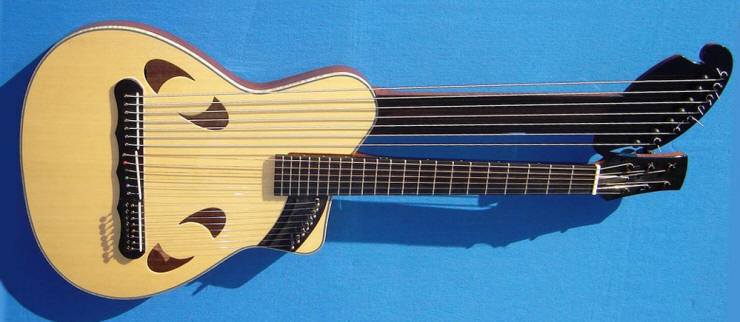

Rich Mermer 21-String Nova
Harp Guitar
Thinline Acoustic-Electric
SOLD

All photos copyright Rich Mermer
|
|
A truly modern instrument, this innovative harp guitar was built by Florida luthier Rich Mermer in 2007. Rich has built many stunning acoustic steel guitars and creative doublenecks (Acoustic Eidolon's Joe Scott tours with a custom Mermer). He has plenty of new ideas about guitar design, (including soundhole placement, as you can see on this one) - and has clearly been thinking about improved modern harp guitar design as well. Rich has been designing, building, and repairing fretted string instruments since 1983, after completing his studies at the Roberto-Venn School of Luthiery in Phoenix, Arizona, where he was greatly influenced by master craftsman and instructor William Eaton, one of the most creative and innovative harp guitar builders of our time. Rich builds about 12 instruments a year - usually client commissions; this is one of the few not designated for a particular client. So perhaps more than any of his creations, this is what Rich strives for in every project - "an individualized, handcrafted, work of art." More than simply artistic, there was clearly a lot of thought put into the technical and ergonomic details as well. Rich explains: "(This instrument) represents an offshoot from my Nova Series of thinline amplified 'acoustic' instruments. This is not a solidbody electric instrument. The body is hollow and the top is full braced, just like an acoustic instrument. This style of instrument can be heard well enough when played unplugged, but it is designed to be played plugged in, sounding like an amplified 'acoustic' instrument. Why the 'thinline' body? While at the Gathering in 2006, I did notice that several people were playing and carrying instruments and cases that were bigger than they were! They did not always look comfortable. I built this alternative style of harp guitar (to) be more comfortable for the player to actually hold and play. An additional bonus is that it is also easier to travel with, as the neck and sub bass extension can easily be removed when traveling. Loosen the sub-bass and main strings, coil the strings from the ball end, and remove the eight allen screws. Now you can remove the neck and sub bass extension, fold them along side the instrument's body, and travel with it packed in a case the size of a small suite case." "The 7 sub-bass strings are (currently) tuned E-F-G-A-B-C-D, from low to high (gauges: .080-.074-.070-.066.-062-.060-.056). I do have sharpening levers for the sub-bass strings, but they have not yet been installed. The 8 super-treble strings are tuned E (an octave above the treble E on the main guitar neck) -F-G-A-B-C-D-E, from low to high (gauges: .017-.016-.015-.013-.012-.012-.011-.011). All totaled, (it has) 21 strings and a 5 octave range." I (GM) do not have this instrument in my possession, so cannot provide my input as far as tone (acoustic or electric) or playability. I did noodle on it briefly at the 2007 Gathering, but was in a noisy room (and I had help - see photo). The trebles were not specifically patterned after the Doan Sullivan-Elliott instrument, so provided their own unique sound. My preference for something like this would be to eschew the standard high-pitched 8-note diatonic scale and experiment with different gauges and tunings to provide a more chordal tuning (which is what I gravitate towards anytime I spend time with "super-treble" harp guitar banks). But, like any harp guitar, the tuning and playing options are limited only by one's creativity. This may be the first true "travel harp guitar" that one can take out of a carry-on, set-up, tune up and play within 10-20 minutes! I wish I had had the opportunity to spend time with the unique Peghed 16:1 tuners - something I wish I had for all my sub-basses! At five grand, this is probably the lowest price yet for a 21-string harp guitar - and yet it comes from an established, respected handcraft luthier (to me, that sounds like a deal). Rich explains that this instrument was designed to be plugged in to get the full amplified 'acoustic' sound, although it can be heard well enough for unplugged rehearsal and practice. Fingerstyle champ Don Alder just demonstrated this instrument at the Newport Guitar Festival and has this to say: "The Mermer Nova Harp guitar is great fun to play, its body size is a lot easier to manage and the pickup system works extremely well. You can play at a loud volume without the usual feedback issues. The action is great and the body size of the guitar is so comfortable to play. If you want an electric version of a harp guitar this one will suit all your needs."
The instrument will ship from Mermer Guitars in Florida, with a generous week-long trial period. |
|
||
Specifications:
Price |
||||
|
CDs &
DVDs by Stephen Bennett, John Doan, Muriel Anderson, Andy McKee,
Stacy Hobbs, Tom Shinness, Dan LaVoie, James Kline, Larry
Berwald, Bill Dutcher, Gregg Miner, Pasquale Taraffo |
All Site Contents © 2006,
2007, 2008, 2009, 2010, 2011, 2012, 2013

PO Box 573155
Tarzana, CA 91357
USA
(818) 884-7937